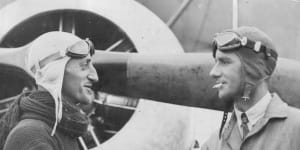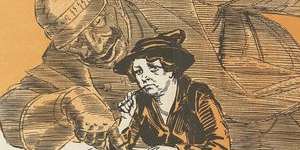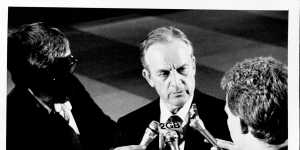Henry Goya Henry,and his successful High Court challenge to the federal government’s desire to police the nation’s skies,led directly to a referendum in 1937 that remains one of the most unusual in the Commonwealth’s history.

Henry Goya Henry (left) with fellow aviator George Littlejohn. It was Henry’s legal fight to keep his pilot’s licence that led to the 1937 referendum.Source unknown
The government of Joseph Lyons asked voters to change the Constitution,written before the Wright brothers invented powered flight,so that the federal government had control of aviation matters.
It wanted the change because Henry,accused of breaching the law by flying too low over Mascot airfield in his plane the Jolly Roger,had argued that the Commonwealth did not have the power to fine him £1 for flying without a pilot’s licence.
Henry,who had caused a huge stir by flying under the Sydney Harbour Bridge two years earlier,took the case all the way to the High Court,which agreed with him.
That prompted the Lyons government to call for a constitutional change. Declaring it “absurd and dangerous” to allow the states to have differing laws covering the rapidly advancing form of transport,the government was quietly confident of success.
But the official No campaign of 1937 told voters there was something much more sinister about the proposed change.
Accusing Lyons and his then attorney-general Robert Menzies of a conspiracy to create a British airline monopoly,the No campaign appealed directly to railway workers and voters in the nation’s many country communities.
“It would wreck the state railway systems,” the No essay to voters noted.
“It would bankrupt country towns. Aviation transport,as in America,would direct purchasing power from country centres. Loss of railway purchasing power would be disastrous to the country businessman.”
Freight costs and food would become dearer,opponents claimed.
On polling day,more than 53 per cent of all Australians backed the change. But it was a majority built in Victoria and Queensland with the Yes case failing as voters in the other four states were marginally opposed.
The aviation question is one of the 44 proposals put to voters since the first referendum was held in 1906. Just eight,including the 1906 proposition which changed the starting date for a new Senate,have passed.
That excludes the two conscription plebiscites of 1916 and 1917 (both lost),the national song question of 1977 (when 43.6 per cent of people backed Advance Australia Fair) and the same-sex marriage postal survey of 2017 (supported by 61.6 of respondents).

An advertisement used in the 1916 and 1917 conscription plebiscites.State Library of NSW
Doubling down
A key issue in the way of success is the “double majority” requirement for a successful referendum. A majority of the national electorate has to back a change as does a majority of the six states.
Professor of history at the Australian National University,Frank Bongiorno,said the double majority concept was drawn from Switzerland’s constitution.
“The federation founders went for this because it was a means of ensuring that the most populous states – Victoria and NSW – would not be able to change the Constitution without the consent of voters in the less populous ones,” he said.
Professor Bongiorno said he doubted the federation founders understood the extent of the problems the double majority issue would create for future generations.
He cited the failed referendum question of 1977 under then-prime minister Malcolm Fraser,who asked voters to alter the Constitution so that elections for both the House of Representatives and Senate were held on the same day.
It was the third time such a question had been put to voters.

Then attorney-general Lionel Bowen conceding defeat to the four referendum questions of 1988.Stephen Lunam
This time,it gained 62 per cent of the national vote,but it failed because three states - Queensland,Western Australia and Tasmania - did not back the change. A change of mind among 8,000 voters in WA would have altered the result,and the Constitution.
Fraser’s predecessor,Gough Whitlam,had sought to modify the double majority rule so that a referendum would be successful if it achieved a majority of votes in three states.
It gained 48 per cent of the overall vote with electors in just one state,NSW,backing the move.
The referendum bellwethers
Some parts of the country are extremely adverse to constitutional change. A majority of voters in the Queensland seats of Maranoa and Wide Bay were the only ones in Australia to oppose the (successful) referendum of 1977 to allow the residents of the ACT and Northern Territory to vote in a referendum.
And there are some areas that are much more likely to say yes to a change.
‘The Yes camp appear to have ... ensured defeat. No bipartisan support,and labelling opponents as people who need to be educated.’
Matt Qvortrup,a constitutional professor at ANU
Going all the way back to the 1906 referendum,the people in and immediately around the NSW city of Newcastle have said yes on more occasions than any other.
Across the 44 referendum questions,the plebiscites and the postal vote,the voters of Newcastle have said yes more than half the time. The federal seat has returned a Labor MP at every election since 1901.
The neighbouring area of the Hunter Valley is also a hotspot of constitutional change.
Electorates covering central Melbourne and Sydney,plus the western suburbs of Melbourne around Footscray have also a long history of voting Yes.
Existing rural seats,such as South Australia’s Grey,Maranoa and Wide Bay in Queensland,Calare and Riverina in NSW,Mallee and Gippsland in Victoria have been adverse to change. That includes their predecessor electorates.
At the 1967 referendum,ending the ban on counting Aboriginal Australians in the census,every electorate in the country said yes. Almost 91 per cent of voters backed the change.
The referendums that might have been
But there were pockets of opposition. In the vast West Australian seat of Kalgoorlie,almost one-in-three voted no. More than 20 per cent of people in other WA seats such as Canning,Moore and Perth voted against the notion.
In the far north Queensland seat of Kennedy,the no vote reached 23.5 per cent while it was around 19 per cent in Cowper and Gwydir (both in NSW),Leichhardt in Queensland and Grey and Angas in South Australia.
Matt Qvortrup,a visiting professor of constitutional law at ANU who forecast the defeat of the Brexit referendum of 2016,said writers of Australia’s Constitution had intended to make it difficult to change.
America,where support of two-thirds of the states are required to alter the constitution,had served as an inspiration for Australia.
According to Professor Qvortrup,the Yes campaign has underestimated its opponents and the institutional issues that make it difficult to alter the Constitution.
“Massively so. The Yes camp appear to have done all the things that ensure defeat - no attempt at bipartisan support,and labelling opponents as people who have to be educated,” he said.
“(Former British prime minister) David Cameron comes across as almost over-prepared compared to Albo.”
Even the most bipartisan referendum can struggle.
In 1937,the Lyons government had all states onside and most of the Labor Party. But even that was not enough to get enough voters in the right parts of the country to back their changes.
Ultimately,the problems caused by the High Court ruling and the referendum defeat were solved by the states willingly handing over their powers to the federal government.
Henry,who had become a bankrupt after he crashed his plane into another a year after the referendum,would eventually make his way to New Guinea where he became known for collecting and selling snakes.
Cut through the noise of federal politics with news,views and expert analysis..